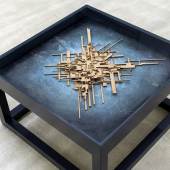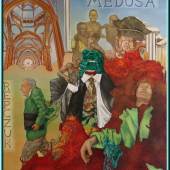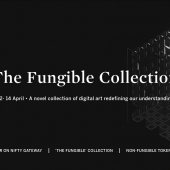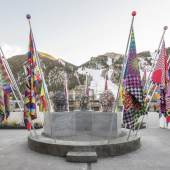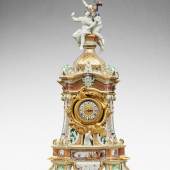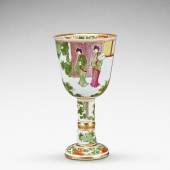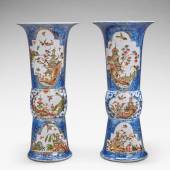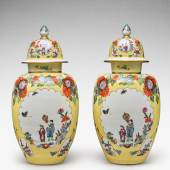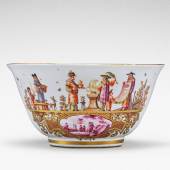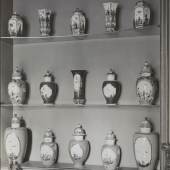Sotheby’s Unveils Highlights from Sammlung Oppenheimer
-
Auktion14.09.2021
As Allied bombing placed the Führer’s art holdings in peril, the Meissen that had been acquired from Mannheimer’s estate was moved for safe keeping first to Vyšší Brod Monastery in Bohemia and later to the salt mines in Bad Aussee. The porcelain was eventually discovered by Allied Monuments Officers and was transferred to the Central Collecting Point in Munich in 1946. The collection was sent back to the Netherlands between 1945 and 1949. After the recovery of the Mannheimer collection, the collector’s executors did not seek restitution, as they would have been obligated to refund the price paid by the Führer’s curators, and the collection passed into Dutch State holdings. Of the porcelain, some was held as property available for restitution and some was transferred to the Rijksmuseum.
Earlier this year the Restitution Commission of the Netherlands accepted that the porcelain in this sale that had belonged to the Oppenheimers must be restituted to their heirs.
AUCTION HIGHLIGHTS
The collection of Franz and Margarethe Oppenheimer exemplifies their penchant for chinoiserie taste, an all-encompassing term from the Victorian era that was applied to pseudo-Asian forms and decorations invented in Europe from the 17th century onward, in response to the exoticism and novelty of contemporary Asian imports. The origins of many of the pieces collected by the Oppenheimers can be associated with royal commissions for Meissen porcelain to decorate the interiors of Augustus the Strong’s colossal ‘porcelain palace’, conventionally known as the Japanese Palace, on the banks of the river Elbe in Dresden-Neustadt.
The September auction is led by a Highly Important Documentary and Dated Meissen Mantel Clock Case from 1727 – undoubtedly the rarest piece in the Oppenheimer collection and illustrative of the Chinoiserie style they so loved (estimate $200/400,000). This magnificent Meissen clock case can be counted among the most ambitious and successful of sculptural models produced at the factory at this early date. The Oppenheimers were able acquire the clock case after it had passed through two prestigious 19th century English collections, at some point between 1923 and 1927. The present clock was originally owned by Ralph Bernal, a politician and discerning art collector, who later became president of the British Archaeological Society in 1853 and whose collection garnered the attention of prestigious museums and connoisseurs alike, including the Rothschilds, the Marquess of Hertford, Marlborough House, the South Kensington Museum, the Tower Armory, and the British Museum. Sir Anthony de Rothschild acquired this particular clock in April 1855 for £120.
At least five varying clock case models were produced at Meissen in the late 1720s and early 1730s, and one can presume that Meissen clocks from this date were intended for the royal industry’s principal client and patron, Augustus the Strong, and were to be included in the rooms of the Japanese Palace. According to the 1733 Specification von Porcilan – a listing of the Meissen porcelain ordered for the Japanese Palace, though not necessarily produced – a total of 14 clocks were ordered. The dating of this compilation – the year of Augustus the Strong’s death – is largely a reflection of the initial orders of the late 1720s. The 14 clocks were allocated to four rooms in the piano nobile and it is even known exactly where on the walls the clocks were intended to be placed.
Only five clocks of this model appear to have survived by the early 20th century, each with slight variations in the modeling, rendering all of them unique. Of the five, two are in museum collections: in the Hermitage in St. Petersburg and the Hetjens-Museum in Düsseldorf.
A Pair of Meissen Augustus Rex Yellow-Ground Baluster Vases and Covers further distinguishes the offering (estimate $150/250,000). According to the 1733 Specification, 'Hoch-Gelb-Couleur', or deep-yellow-color, Meissen porcelain was allocated to so-designated Room 3 of the Japanese Palace, in between rooms for seladon, a shade of green, and dark-blue-ground Meissen porcelains. This large order of yellow-ground porcelain included approximately 267 vases, bottles and beakers, including 6 garnitures formed of seven vases and 2 garnitures formed of five vases, among other pieces. A yellow-ground ogee vase decorated in the same manner and formerly in the Royal Collections of Saxony, Dresden, may once have formed a garniture with the present vases. That vase, missing since 1945, was originally installed in the tower room of the Royal Palace. In addition, the somewhat unusual leaf-form cartouches seen on the present vases are recorded on Chinese Kangxi vases, examples of which were in Augustus the Strong's collection, now in the Porzellansammlung, Dresden.
A Very Rare Pair of Meissen Augustus Rex Underglaze Blue-Ground Beaker Vases are also in the sale (estimate $70/100,000). An unusual feature of the present pair of vases is the use of two alternating different green enamels on the cartouches, the significance of which is uncertain and invites further research. One possibility is that painters worked in their own personalized enamel palettes which could indicate two different hands painted these vases. The same feature is seen on a smaller underglaze blue-ground vase of this form, in the collection of the Porzellansammlung, Dresden.
-
12.04.2021 - 14.04.2021By Pak • 12- 14 April • A novel collection of digital art redefining our understanding...
-
20.04.2022ARTEXPO NEW YORK CELEBRATES ITS 45TH ANNUAL EDITION WITH A RENAISSANCE IN CONTEMPORARY AND FINE...
-
23.05.2018NEW YORK, 16 May 2018 – Today, Sotheby’s is honored to unveil the full contents of A...
-
Gegen Ende seine Lebens malt und zeichnet Cézanne wiederholt das Motiv der "Badenden"....
-
20.04.2024 - 24.11.2024Jeffrey Gibson on Representing the United States and Himself By Melissa Smith | Feb 16, 2024 From...
-
11.12.2024Iconic Heuer Monaco Worn by Steve McQueen in LeMansRaces to Auction at Sotheby’s New York...
-
14.09.2021Auktion »
.
